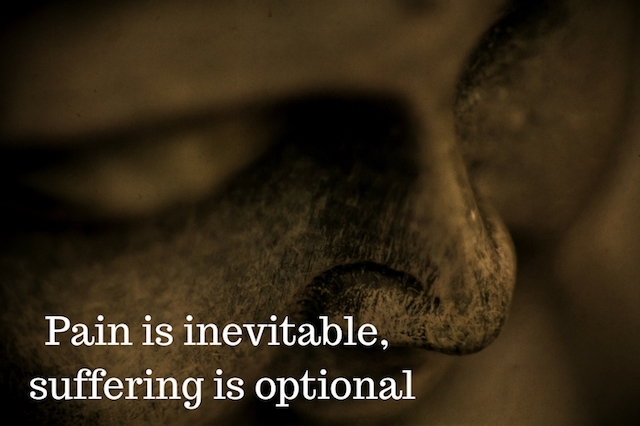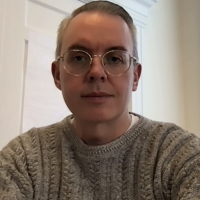
{Cutting Through} is a new column on elephantjournal.com. Have a question about meditation, mindfulness, or Buddhism? Please send it to Travis at [email protected] or in a comment on this article. Travis is an authorized meditation instructor in the Shambhala Buddhist lineage and the Center Director of Shambhala St. Petersburg. He is a joyful student of Sakyong Mipham Rinpoche.
Question: From what I understand about the Buddha’s time, six years prior to his enlightenment there was a good deal of suffering on his part. It seems odd that the first thing he did upon becoming enlightened was to establish The Four Noble Truths where he posited that no one should suffer. How can we become “enlightened” without suffering? It appears that there is no personal growth without suffering.
~
Thank you for your question.
Before I attempt to address this question, let’s catch everyone else up who may not be familiar with the Buddha’s teaching on The Four Noble Truths.
As the questioner mentioned, it is said that upon attaining enlightenment, the Buddha struggled personally with how he would communicate what he had gone through and the insight that arose from his experience. After some time, the Buddha delivered his first teaching: The Four Noble Truths (alternate, and perhaps more accurate translation: The Four Truths of the Noble One).
Before we go into the question more deeply, here, simply, is what the four truths are:
- The existence of dukkha, suffering: Dukkha, which could also be translated as dissatisfaction or discontent, manifests throughout our lives—because of our ignorance—in the form of birth, aging, sickness, and death and all that comes with that.
- This suffering has a cause: That statement implies that the suffering is not inherent, but caused by something. The Buddha observed that trishna, grasping and clinging—in an effort to ameliorate our suffering—is actually the cause of our suffering.
- The cessation of suffering: Since dukkha has a cause (trishna), it can also be stopped. I’m using the Sanskrit words, not to be fancy-pants, but because words like “suffering” and “attachment” seem too coarse and lack the nuance of what is meant by the teaching.
- The eightfold path: This is the Buddha’s prescription for ending the aforementioned dukkha. The eightfold of the eightfold path refers to right view, right aspiration, right speech, right action, right livelihood, right effort, right mindfulness, and right concentration.
So, why was this the Buddha’s first teaching?
The motivation for the Buddha teaching at all was his limitless compassion for sentient beings. He realized, as most of us do, that people just want to be happy. He also witnessed the suffering around him, which is what led him on his path to begin with.
What the Buddha discovered was that people suffer, experience dissatisfaction and discontentment, unnecessarily. Furthermore, we do it to ourselves.
If you’re a compassionate kinda gal and you see a bunch of people walking around town punching themselves in the face, and also crying about their face hurting, you might be like, “I see that your nose is bleeding. Let me tell you why it’s bleeding, and how you could stop it from happening in the future. Follow these steps and you too could not have a bloody nose and hurt face and hurt hand and ruined shirt!”
How do we cause our own suffering?
As Khenpo Tsultrim Gyamtso RInpoche pointedly explains in his classic work, The Progressive Stages of Meditation on Emptiness, the dukkha we experience occurs because we’re trying to do things that are not possible. First and foremost, we don’t even exist in the sense that we assume. Secondly, everything is impermanent, so when we grasp on to some thing, any thing, we’re headed for trouble because there isn’t anything particularly to grasp and hold on to in a lasting sense, and there isn’t even anyone to do the holding!
Furthermore, it seems to be that the conditioned affliction of grasping is the actual problem, and the idea that we are somehow incomplete and needing of something external to make us whole…is a bad one.
What we find as we move along the path, or as Buddhist teacher Carol Hyman put it, on a play on the book title above, to use meditation to move through the progressive stages of relaxation into openness, is that when we relax the impetus to grasp and just peacefully abide in the moment, there is actually nothing missing. We are complete and whole already, and underneath the neurotic whirlwind of self-defeating behavior lies an ocean of sanity—and feelings of well-being and contentment.
So, now that we’ve reviewed briefly why we “suffer,” let’s look into the idea that suffering is necessary for growth.
The Buddha’s teaching on the Four Noble Truths were not about trying to avoid suffering as a form of escaping from reality. He also didn’t, too my very limited knowledge, suggest that “no one should suffer.” Again, what he did say is that we suffer needlessly due to our ignorance.
What happens when we have cut the root—ignorance—of our suffering? Do we no longer grow as people? Do we ride unicorns in dewy meadows for the rest of our lives while the world burns around us? I effing hope not.
The idea is that once we are living the eightfold path and have discovered (as an experience) the cessation of suffering, we will then be better equipped to handle what life throws at us. Our natural intelligence and insight won’t be clouded over by a bunch of neurotic habitual patterns. Instead of reacting out of our conditioning, and causing ourselves and others further harm and suffering, we can act skillfully in a manner that is needed for that time and situation.
The growth won by suffering is piecemeal and inefficient. It happens often begrudgingly and in a manner that is unnecessarily difficult.
Do we think that because we have lost a loved one, or went through a divorce, or have beaten cancer, that we can now handle situations better than an awakened being like the Buddha or Chögyam Trungpa? Both we and the Buddha will still feel pain, of course, but that doesn’t necessarily have to be a “bad” experience either.
One time during a Q & A, someone asked Trungpa Rinpoche what he meant by “bliss” as he had used the word several times in this talk. Rinpoche’s response was, “It’s what you call pain.”
Suffering, in this context, is what happens after the pain.
Here is a practice from a teaching by Pema Chödron that explains how we could work with pain without suffering from it.
We have all suffered from dukkha a lot already—according to traditional Buddhist teachings, for aeons of lifetimes. We’ve struggled greatly because of our neuroses and confusion. At the end, we’re slightly better off for when we have to go through it again.
Even without being a “realized master,” our practice can help us deal with situations more skillfully. The simple technique of mindfulness meditation can help us break our habit of being led down a rabbit hole of pain and wallowing, and help us let go of the hook and come back to reality.
It seems to me that the type of self…selfless-actualization the Buddha gave us the guide book for is the most impressive way we can grow as humans.
~
For an in-depth look at The Four Noble Truths, see The Truth of Suffering and the Path of Liberation by Chögyam Trungpa.
~
Relephant Read:
{Cutting Through}: Motivation. Is my Intention to Meditate Pure? {Weekly Q & A}
~
~
~
~
Author/Image: Travis May











Read 13 comments and reply